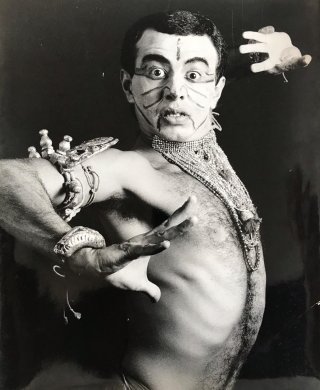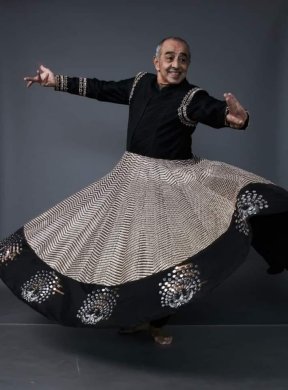 |
  |
 |
  |
Churned energies of absolute ecstasy - Astad Deboo - Navina Jafa e-mail: navina.jafa@gmail.com Photos courtesy: Astad Deboo archives March 20, 2021 Linking the ethos of the Parsi religion to dance is both quixotic and interesting. The approaching Parsi New Year Navroz (on March 20) provides an occasion to do so. The lone figure whirled atop in the Indira Gandhi Centre for the Arts. The churning of the dancer lit up like a 'Bindu.' The figure moved it, giving way to concentric circles of emanating energies, slow and continuous. Yet, magically, the figure itself in the centre like a 'Bindu' communicated a potential seed's stillness. The dancing figure was none other than the iconic contemporary Indian dancer Astad Deboo who passed away in December 2020. Astad began his journeys in dance with Kathak. In this form, the 'chakkars' (pirouettes) operate as a tool for completing a ritual in the larger frame of a spiritual aesthetical pilgrimage. He later delved into Kathakali, the ancient theatrical form honing the expressional art of communicating emotions. His immersion in dances and dancers from various traditions from India and worldwide gave him the multilingual vocabulary of organizing communicative movements to project contemporary themes. On a parallel level, he was a warrior on a mission, a humanist who explored and advocated social change through dance.  The question remains - what made him distinct? Where does one locate his work in the trajectory of contemporary Indian dance? A distinctive aspect of his work remained to cross folk-classical boundaries; he created a fluid category of movement which involved martial, acrobatic, and many more traditions of dance expressions. His themes were contemporary, intense, and revealing. His sister Gulshan expressed, "He was the dancer of the underdogs." He reached out to street children as much as differently-abled children. These engagements provided the fuel to innovate with expressions of dance communication. However, the idiom of contemporary Indian dance preceded Deboo. At the turn of the 20th c, inspired by Hindu mythology, the pioneers of Modern American Dance - Ruth St. Denis and Ted Shawn - created 'Radha' in the contemporary genre. They later presented Uday Shanker's 'Oriental dance' to the West. Shanker went on to choreograph pieces for prima ballerina Anna Pavlova ('Radha-Krishna' and 'A Hindu Wedding'). The negotiation of the emerging 'contemporary' genre in India started. Uday Shanker re-invented the 'exotica' of Gods and Goddesses of Indian dance from temple/courts to prosceniums and took Indian movements, costumes using theatrical production tools. It hypnotized the West. Astad Deboo, on the other hand, provided the trajectory of Indian dance with a specific in-depth cosmopolitanism that carried with it the inner frame of the Zoroastrian spirit. Thus, it was not surprising that his work 'Elemental Divine' depicting the four "sacred" elements in Zoroastrianism featured almost a central piece in the exhibition 'Threads of Continuity: Zoroastrian Life and Culture' in 2016 at the IGNCA.  Before the COVID lockdown in early 2020, in his last production titled 'Unbroken Unbowed,' he explored Gandhi's essence. Costume designer Sandhya Raman remarked, "As I took the measurements under his tee-shirt, I found that he wore the handwoven woolen 'Kasti' over the 'Sadra.' The kasti woven by his mother functioned perhaps like an umbilical cord." The Sadra and Kasti are the Zoroastrians' religious implements, forming a circuit of prayers around the physical body, protecting from hostile forces, and laying to the path of duty. Says Raman, "For me, the costume is second skin to personify who you are, what you say no matter what medium you use to say it. For the 'Unbroken Unbowed,' it was the spirit of the concept showcasing what Astad aspired to create - fearlessness and the grace of being humane marked by simplicity. These ideas led to the creation of intending to capture the amalgamation of complex subtleties. For instance, at every stage of the conceptualization, we discussed the theme. Complicated emotions caught in layers and textures juxtaposed ensured the coexistence of various emotions. The khadi fabric choice aspired to reflect the soul brought in the thread to bind this unique production, and the use of white acted as a clean canvas to display the dynamics of emotions." Shernaz Cama, Director of the UNESCO Parzor Project for the Preservation and Promotion of Parsi Zoroastrian Culture and Heritage, said that Astad Deboo's exploratory spirit of creating multicultural aesthetics was inherently reflective of the Parsi 'Magpie culture.' "It is a spirit that seeks to appropriate to celebrate the essence of beauty. We embrace beauty inspired by the concept of Fravarshi which means 'essence' and a guardian that drives the inner spirit." The Fravarshi is represented in the figure of Farohar in the Parsi Fire Temple. It is a human torso with wings— the human torso signifying humanity and the wings the moving sun. Says Cama, "The intention of the devout is to celebrate the spenta or the bountiful. To be enveloped and to envelope the good in the creation. To give back joy." In exploring the spenta, Astad immersed in his chosen themes and then created a collage of aesthetics that evolved into a sophisticated production. His productions involved the idea of light, exquisite music, sets, and dialogue with other arts like Puppets. His sister Gulshan says that his grand ecology of performance "held the audience spellbound. His music stood out in all his productions. He listened to all kinds of music. Perhaps there was a germ of an idea already, or the music inspired the idea. Whatever, the music was always for his dance and not the other way round."  Rooted in the Parsi sacred frame, Astad's production defined the body of transmission methods and the dances' technical vocabulary. His inner body dressed in Kasti and Sadra, and his braided hair symbolized the intense, focused mental energies. There was the immediacy of the 'Now' in his productions. Even when the transition from rehearsal to the stage, despite pre-recorded music, had the 'Now.' The internal focus created that now in the churning of the whirl that flowed in his layered robes. Gendered sexuality dissolved as the human spirit manifested itself as an epiphany. The process was the sudden unraveling of the sacred. Quoting art critic Roger Lipsey who describes Astad's work, "as if it is shored up behind barriers and unexpectedly breaks into human awareness." The living fire of the inert 'Bindu' of Raza returned to Persian Rumi and Saadi. The corporeal body was left in death to return to Nature placed above the Tower of Silence, and the breeze came to reflect the layered robes churned amidst a dancing floating cloud - Astad Deboo!  Navina Jafa did her Phd on socio-economics, and aesthetics in the world of Kathak Dance in 6 urban towns of North India under Dr. Kapila Vatsyayan and urban historian Prof. Narayani Gupta. She learned Kathak from Gurus Pt. Birju Maharaj, Munna Shukla and Reba Vidyarthi. A Fulbright scholar at the Smithsonian Museum, she worked on cultural management and diplomacy. She runs a business on Academic Tourism and is vice president of Centre for New Perspectives presently working to create sustainable livelihoods for marginalized street-folk performers. Post your comments Please provide your name and email id along with your comment. All appropriate comments posted with name and email id in the blog will also be featured in the site. |